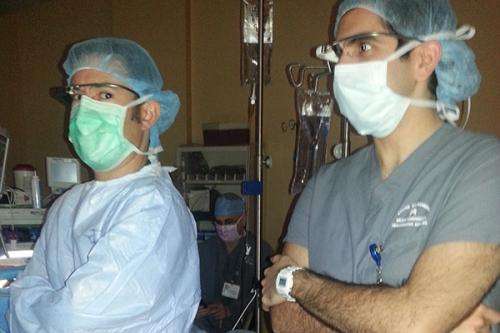Using Google Glass in the operating room

At this point, only a few people are using Google Glass, Google's wearable eyeglasses-like computer. The device isn't yet commercially available.
Who are these trailblazers? Well, one is Ajay Kohli, a Drexel medical student.
Kohli is in his third year in the Drexel College of Medicine, and he's helping to discover new ways to use Google Glass during his rotations at Kaiser Permanente Hospitals in Sacramento, where the College of Medicine began sending some of its third-year students in a partnership struck last year.
"Wearable devices are the next wave, after smartphones," Kohli said. Kohli worked in finance before he enrolled in medical school, developing an interest in technology and "big data" analytics.
After he pitched a few ideas to Google about how Glass could improve medical care, the company agreed to make him one of its Glass Explorers—the small group of testers working to discover what's possible with the device while Google prepares it for the market. Along with a surgeon who's also an Explorer, he's been brainstorming uses for Google Glass in the operating room during his surgery rotation. The two are among a small group of people around the country looking into uses for Glass in the medical field.
"I think this has the capacity to change how we practice medicine," Kohli said.
One of the first applications they found was to use Glass to stream surgical procedures to students, right from the surgeon's point of view. Viewers could watch exactly how a tumor appeared, how the surgeon stopped bleeding and how he made decisions, all from the same vantage point they would have when they performed the procedure themselves.
"It's essentially a live experience, without being in the room," Kohli said.
Kohli and the surgeon and fellow Explorer are also considering other ideas, such as using Glass to help with the detection of skin cancer—perhaps Glass could report the probability that a skin lesion is cancerous.
The possibilities seem endless, Kohli said. Glass could help doctors, nurses and other care providers integrate data and analytics into virtually everything they do—the computer could analyze their view of an intensive-care patient's room to ensure that the head of her bed is properly elevated, ventilator settings are correct and her legs are moving sufficiently to prevent blood clots.
"Anywhere where you have a lot of data and a lot of analytics, Glass has the capacity to really streamline those analytics and improve the quality of care," Kohli said. "You can make sure patients are receiving the right care that they need at the right time."
Kohli gets to use the device in his free time, too, and he said it's been a blast. The device's viewing field—which he said requires one to glance upward outside the normal field of vision, so it doesn't get in the way—will automatically display driving directions to a location when he receives a text message from a friend asking to meet at a restaurant. It remembers that he has a taste for ice cream, periodically suggesting new ice cream spots nearby.
"It kind of blows your mind," Kohli said.
Kohli said he's not sure if there will be a day when every doctor or nurse roaming the halls of a hospital will be wearing Google Glass. But if that does happen, he said, it would be pretty cool. And it may help save lives.



















